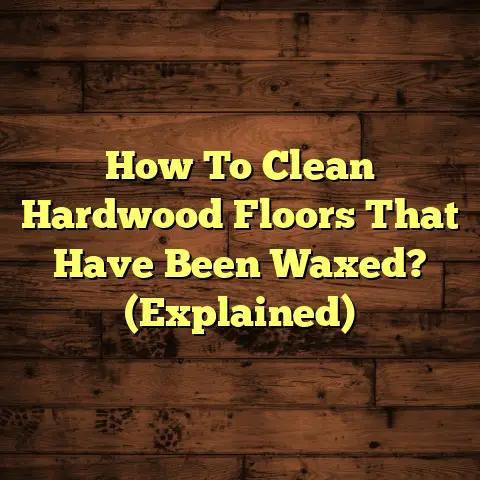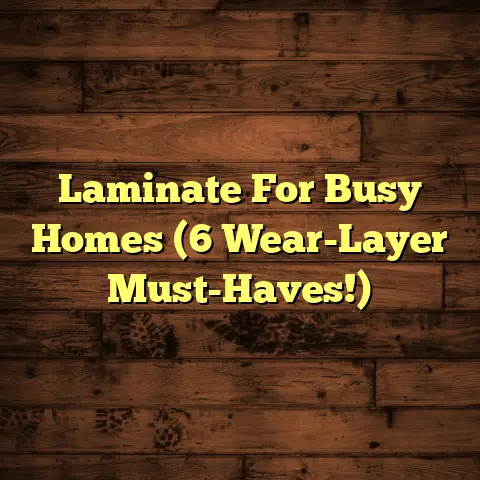Wood Floors Cupping: Causes? (3 Fixes, Act Now!)
“The strength of the team is each individual member. The strength of each member is the team.” — Phil Jackson
Ever walked into a room and felt like your hardwood floors were giving you a subtle “hello” wave?Unfortunately, that wave might not be so friendly.
I’m talking about cupping, a common but frustrating issue that plagues many homes with hardwood floors.
As a seasoned flooring contractor, I’ve seen my fair share of cupped floors.
Trust me, it’s more common than you think!
What exactly is cupping? It’s when the edges of your wood floorboards rise higher than the center, creating a concave or “cupped” appearance.
Visually, it can be an eyesore, making your beautiful floors look uneven and worn.
Structurally, it can lead to squeaks, instability, and even potential damage to the floor’s finish.
Why is it so crucial to address cupping promptly?
Well, ignoring it can lead to more extensive and costly repairs down the line.
Plus, it often indicates an underlying moisture problem that could affect the overall health of your home.
In this article, I’m going to break down the mystery of wood floor cupping.
We’ll explore the root causes behind this issue and, more importantly, I’ll give you three actionable fixes you can implement to restore your floors to their former glory.
So, grab a cup of coffee (or maybe a dehumidifier!), and let’s dive in!
Section 1: Understanding Wood Floor Cupping
What is Wood Floor Cupping, Anyway?
Okay, let’s get down to brass tacks.
Wood floor cupping is a distortion of your hardwood floorboards where the edges of the boards become higher than their centers.
Think of it like a shallow bowl or a gentle “U” shape across the width of each board.
You might notice it by running your hand across the floor – it won’t be smooth and flat.
Instead, you’ll feel the edges sticking up slightly.
The Science Behind the Curve: Wood and Moisture
Why does this happen? It all boils down to the nature of wood.
Wood is a hygroscopic material, meaning it naturally absorbs and releases moisture from the surrounding environment.
When the bottom of the wood floorboard absorbs more moisture than the top, it expands more on the underside.
Cupping vs. Crowning vs. Warping: Know the Difference
Now, let’s clear up some common confusion. Cupping isn’t the only type of wood floor distortion.
Here’s a quick rundown:
- Cupping: Edges are higher than the center (concave).
- Crowning: Center is higher than the edges (convex) – often happens after cupping when the moisture source is removed and the board dries unevenly.
- Warping: General twisting and bending of the board in various directions.
Understanding these differences is crucial for diagnosing the problem correctly.
Cupping: More Common Than You Think
You might be surprised to learn just how prevalent cupping is.
While precise statistics are hard to come by, industry surveys and my own experience suggest that a significant percentage of homes with hardwood floors experience cupping at some point.
Factors like geographic location (areas with high humidity), the age of the home, and the quality of the initial installation all play a role.
Common Misconceptions That Lead to Cupping
Here are some misconceptions that lead to cupping:
- “My floors are sealed, so they’re waterproof.” Not true! Sealants offer protection, but they’re not impenetrable.
- “I mop my floors every day; they’re clean!” Excessive moisture from wet mopping can seep into the wood.
- “My house is new, so everything is perfect.” New construction can sometimes trap moisture in the subfloor.
Section 2: Causes of Wood Floor Cupping
Alright, let’s get to the heart of the matter: what causes wood floor cupping?
In my experience, it almost always boils down to moisture imbalance.
Here’s a breakdown of the most common culprits:
Moisture Imbalance: The Root of the Problem
This is the big one. Excess moisture is the primary driver of cupping.
Here’s how it can happen:
- Humidity: High humidity levels, especially in bathrooms, kitchens, and basements, can cause the wood to absorb moisture from the air.
- Leaks: Plumbing leaks, roof leaks, or even appliance leaks can introduce significant amounts of water to the subfloor and the underside of the wood flooring.
- Flooding: Even minor flooding events can saturate the wood and lead to cupping.
Seasonal Changes and Their Impact
Seasonal changes in moisture levels can also wreak havoc.
In the summer, high humidity can cause expansion, while in the winter, dry air from heating systems can lead to contraction.
Improper Installation: Setting the Stage for Disaster
A poor installation job can set the stage for cupping down the road.
Here are some common installation mistakes I’ve seen:
- Inadequate Acclimation: Wood flooring needs to acclimate to the home’s environment before installation. If it’s installed too soon, it can expand or contract excessively later on.
- Improper Sealing: Failing to properly seal the edges and seams of the flooring can allow moisture to penetrate.
- Incorrect Fasteners: Using the wrong type of nails or staples can prevent the wood from expanding and contracting naturally.
Subfloor Problems: The Hidden Culprit
The subfloor is the foundation upon which your wood flooring rests.
If the subfloor is compromised, it can lead to cupping.
Here’s what to watch out for:
- Mold and Mildew: Mold growth in the subfloor indicates excess moisture and can directly affect the wood flooring above.
- Poor Ventilation: Lack of adequate ventilation in crawl spaces or basements can trap moisture and create a breeding ground for problems.
- Water Damage: Previous water damage to the subfloor, even if seemingly resolved, can leave residual moisture that affects the wood flooring.
How to Check Your Subfloor
Here are some ways to check your subfloor:
- Visual Inspection: Look for signs of water stains, mold, or rot.
- Moisture Meter: Use a moisture meter to measure the moisture content of the subfloor.
- Smell Test: A musty or moldy odor can indicate a moisture problem.
Neglecting Maintenance: A Recipe for Disaster
Even with proper installation and a healthy subfloor, neglecting maintenance can lead to cupping.
Here’s how:
- Unattended Spills: Allowing spills to sit on the floor can allow moisture to seep into the wood.
- Excessive Wet Mopping: Over-wetting the floor during cleaning can saturate the wood fibers.
- Lack of Humidity Control: Failing to maintain a consistent humidity level in the home can exacerbate moisture problems.
Routine Care: Your First Line of Defense
The best way to prevent cupping is through consistent routine care.
This includes:
- Wiping up spills immediately.
- Using a damp (not wet) mop for cleaning.
- Maintaining a consistent humidity level (ideally between 30-50%).
Section 3: Three Fixes for Wood Floor Cupping
Alright, let’s talk solutions. If you’re dealing with cupped floors, don’t despair!
Here are three fixes you can try, ranging from simple DIY solutions to professional interventions:
Fix 1: Address Moisture Issues: The Foundation of Recovery
The first and most crucial step is to identify and address the source of the moisture.
Without tackling the underlying cause, any other repairs will be temporary at best.
Identifying Moisture Sources
- Check for Leaks: Inspect plumbing fixtures, appliances, and the roof for any signs of leaks.
- Monitor Humidity: Use a hygrometer to track humidity levels in your home.
- Inspect the Subfloor: As mentioned earlier, check for signs of moisture in the subfloor.
Step-by-Step Instructions for Moisture Control
- Dehumidifiers: Place dehumidifiers in areas with high humidity, such as basements and bathrooms.
- Fix Leaks: Repair any leaks promptly to prevent further water damage.
- Improve Ventilation: Ensure adequate ventilation in crawl spaces and basements. Open windows or use fans to circulate air.
- Use Air Conditioner: Air conditioning helps to remove moisture from the air.
Measuring Moisture Levels in Wood
Use a moisture meter to measure the moisture content of your wood flooring.
Ideal conditions are:
- Wood Flooring: Between 6-8% moisture content.
- Subfloor: Within 2-4% of the wood flooring’s moisture content.
Case Study: Humidity Control Saves the Day
I worked with a homeowner who had severe cupping in their bathroom. After investigating, we discovered that the bathroom fan was not functioning properly, leading to excessive humidity after showers.
By replacing the fan and consistently using a dehumidifier, we were able to bring the humidity levels under control, and the cupping gradually subsided over time.
Fix 2: Repairing and Replacing Damaged Boards: A Hands-On Approach
Once you’ve addressed the moisture issues, you can focus on repairing the damaged boards.
This may involve sanding down the cupped boards or replacing them altogether.
Sanding Down Cupped Boards
Sanding can be an effective way to restore a flat surface to mildly cupped floors.
Here’s the general process:
- Rent a Drum Sander: You can rent a drum sander from most home improvement stores.
- Start with Coarse Grit: Begin with a coarse-grit sandpaper (e.g., 36-grit) to remove the unevenness.
- Gradually Increase Grit: Progress to medium-grit (e.g., 60-grit) and then fine-grit (e.g., 100-grit) sandpaper for a smooth finish.
- Vacuum Thoroughly: Vacuum up all sanding dust before applying a new finish.
- Apply a New Finish: Apply several coats of a high-quality polyurethane finish to protect the wood.
When to Replace vs. Repair
- Mild Cupping: Sanding may be sufficient.
- Severe Cupping: Replacement is often necessary.
- Damaged Boards: If the boards are cracked, split, or rotted, they should be replaced.
Cost and Materials Needed
- Sanding: Rental of drum sander ($50-$100 per day), sandpaper ($20-$50), polyurethane finish ($50-$100 per gallon).
- Replacement: New wood flooring (price varies depending on type), adhesive or fasteners, saw, measuring tools.
Tips for Matching New Boards
- Bring a Sample: Take a sample of your existing flooring to the store to ensure a close match.
- Consider Grain and Color: Pay attention to the grain pattern and color variations in your existing flooring.
- Acclimate New Boards: Allow the new boards to acclimate to your home’s environment before installation.
Case Study: A Seamless Replacement
I once helped a homeowner replace several severely cupped boards in their living room. We carefully matched the new boards to the existing flooring in terms of species, color, and grain pattern.
After sanding and refinishing the entire floor, the replaced boards blended seamlessly with the rest of the flooring, creating a uniform and beautiful look.
Fix 3: Seeking Professional Help: Knowing When to Call the Experts
Sometimes, DIY solutions are not enough, and it’s best to call in the professionals.
Here are some scenarios where professional help is recommended:
- Extensive Damage: If a large area of your flooring is cupped or damaged, it’s best to hire a professional.
- Improper Installation: If the cupping is due to improper installation, a professional can assess the situation and provide the necessary repairs.
- Subfloor Problems: If the subfloor is damaged or requires extensive repairs, a professional can handle the job safely and effectively.
- Lack of Experience: If you’re not comfortable with sanding, replacing, or refinishing wood floors, it’s best to leave it to the experts.
Choosing a Reputable Flooring Contractor
- Get Referrals: Ask friends, family, or neighbors for recommendations.
- Check Online Reviews: Read online reviews to get an idea of the contractor’s reputation.
- Verify Licensing and Insurance: Ensure the contractor is licensed and insured.
- Get Multiple Quotes: Obtain quotes from several contractors before making a decision.
- Ask Questions: Don’t hesitate to ask questions about their experience, methods, and materials.
What to Expect When Hiring Professionals
- Assessment: The contractor will assess the damage and provide a detailed plan of action.
- Preparation: The contractor will prepare the area by removing furniture and protecting surrounding surfaces.
- Repair or Replacement: The contractor will repair or replace the damaged boards as needed.
- Sanding and Refinishing: The contractor will sand and refinish the floor to create a uniform look.
- Clean-Up: The contractor will clean up the work area and dispose of any debris.
Case Study: Professional Intervention Saves the Day
I was called in to assess a home with widespread cupping throughout the entire first floor. It turned out that the original installation was done incorrectly, with no vapor barrier installed over the concrete slab.
We removed all of the flooring, installed a proper vapor barrier, and reinstalled new hardwood flooring.
The homeowner was thrilled with the results and relieved to have the problem resolved once and for all.
Conclusion: Act Now to Save Your Wood Floors!
So, there you have it: a comprehensive guide to understanding and fixing wood floor cupping.
As we’ve discussed, cupping is primarily caused by moisture imbalance, often stemming from humidity, leaks, improper installation, or subfloor problems.
By addressing the root causes and implementing the fixes I’ve outlined – controlling moisture, repairing or replacing damaged boards, or seeking professional help – you can restore the beauty and integrity of your wood floors.
Remember, swift action is key. The longer you wait, the more extensive the damage can become, leading to more costly and time-consuming repairs.
Don’t let your beautiful wood floors suffer any longer.
Assess your flooring conditions today, implement the fixes I’ve described, or seek professional assistance without delay.
Your floors (and your wallet) will thank you for it!





